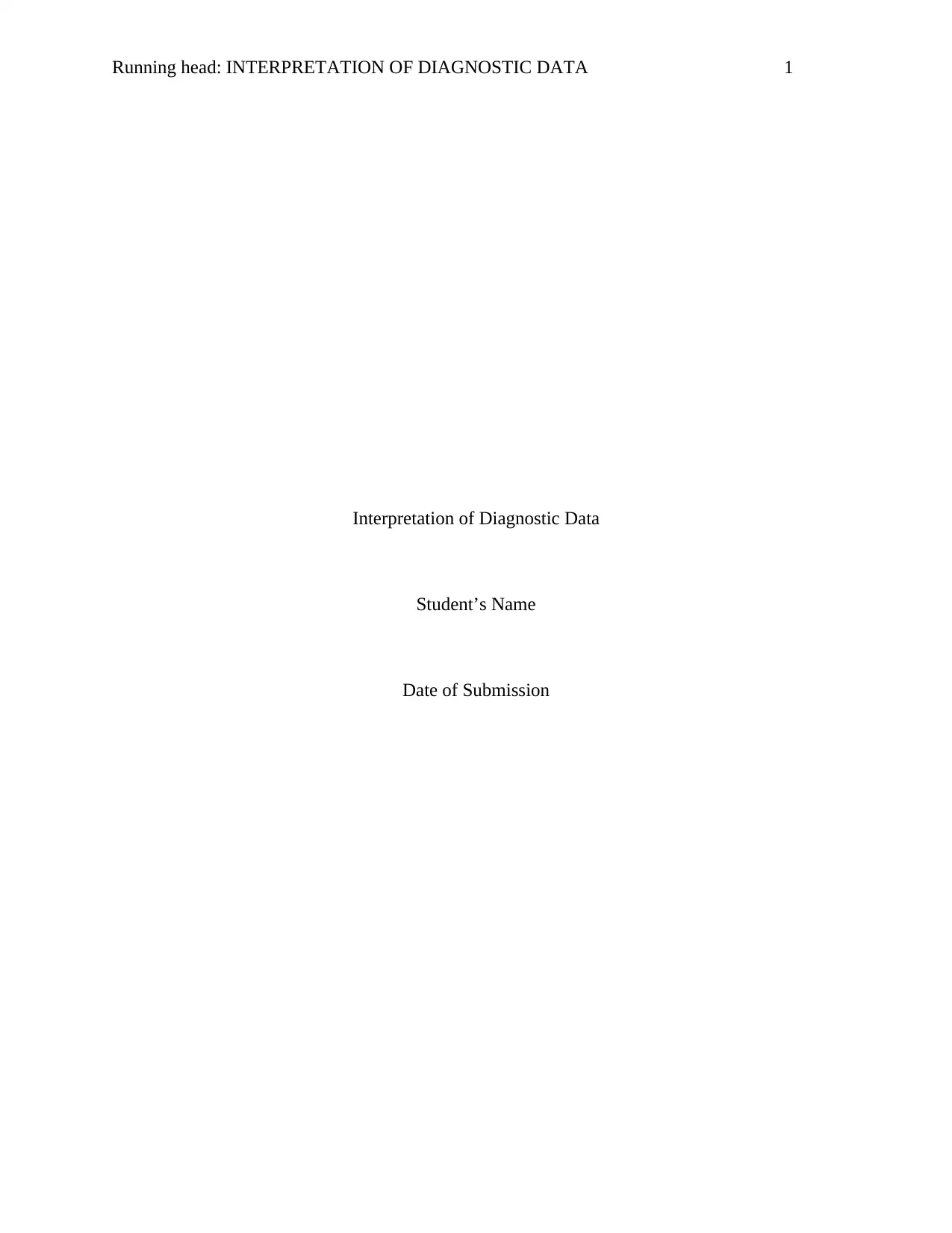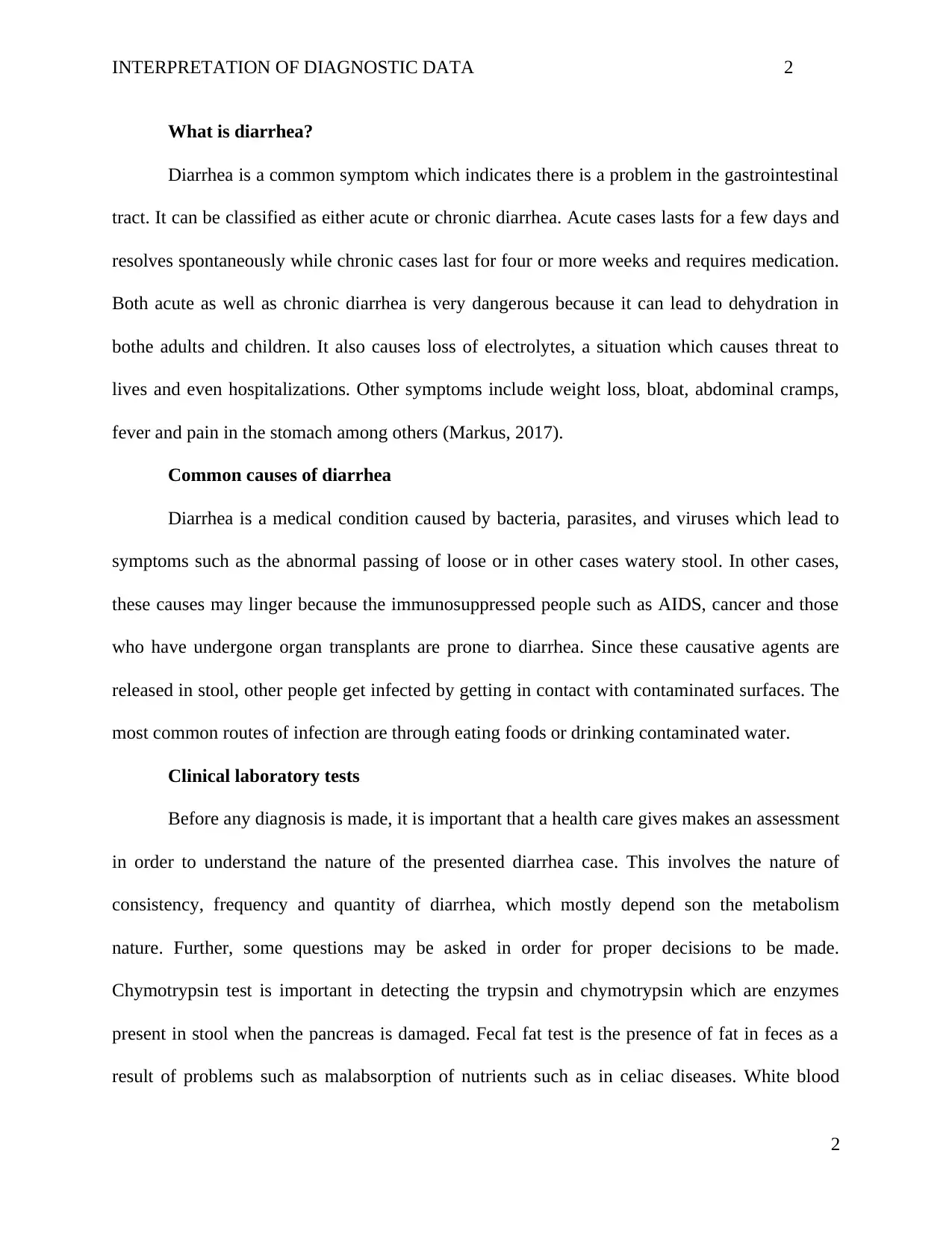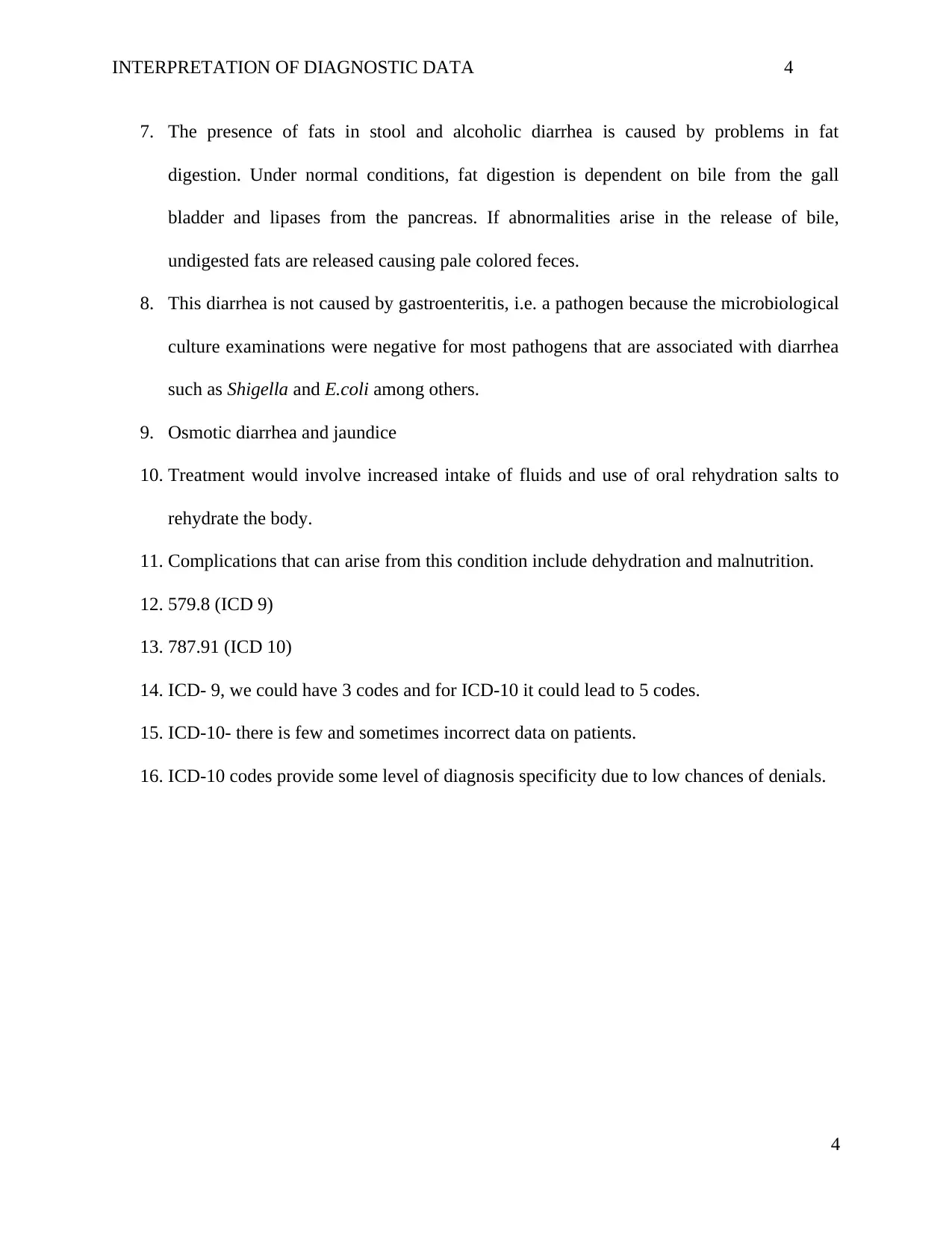Diagnostic Data Interpretation: Diarrhea Case Study
VerifiedAdded on 2019/11/08
|5
|875
|184
Case Study
AI Summary
This document presents a case study focused on the interpretation of diagnostic data related to diarrhea. It begins by defining diarrhea, its types (acute and chronic), and common causes, including bacterial, parasitic, and viral infections. The case study then delves into clinical laboratory tests used for diagnosis, such as chymotrypsin, fecal fat, and white blood cell tests. Treatment options, including rehydration and dietary modifications, are discussed. The case study presents abnormal results, leading to a diagnosis of osmotic diarrhea and steatorrhea, and explains the underlying mechanisms. It also addresses the role of bile and pancreatic lipases in fat digestion. The document concludes with a discussion of ICD-9 and ICD-10 codes, highlighting the importance of diagnostic specificity. The case study emphasizes the importance of proper diagnosis and treatment to avoid complications like dehydration and malnutrition.

Running head: INTERPRETATION OF DIAGNOSTIC DATA 1
Interpretation of Diagnostic Data
Student’s Name
Date of Submission
Interpretation of Diagnostic Data
Student’s Name
Date of Submission
Paraphrase This Document
Need a fresh take? Get an instant paraphrase of this document with our AI Paraphraser

INTERPRETATION OF DIAGNOSTIC DATA 2
What is diarrhea?
Diarrhea is a common symptom which indicates there is a problem in the gastrointestinal
tract. It can be classified as either acute or chronic diarrhea. Acute cases lasts for a few days and
resolves spontaneously while chronic cases last for four or more weeks and requires medication.
Both acute as well as chronic diarrhea is very dangerous because it can lead to dehydration in
bothe adults and children. It also causes loss of electrolytes, a situation which causes threat to
lives and even hospitalizations. Other symptoms include weight loss, bloat, abdominal cramps,
fever and pain in the stomach among others (Markus, 2017).
Common causes of diarrhea
Diarrhea is a medical condition caused by bacteria, parasites, and viruses which lead to
symptoms such as the abnormal passing of loose or in other cases watery stool. In other cases,
these causes may linger because the immunosuppressed people such as AIDS, cancer and those
who have undergone organ transplants are prone to diarrhea. Since these causative agents are
released in stool, other people get infected by getting in contact with contaminated surfaces. The
most common routes of infection are through eating foods or drinking contaminated water.
Clinical laboratory tests
Before any diagnosis is made, it is important that a health care gives makes an assessment
in order to understand the nature of the presented diarrhea case. This involves the nature of
consistency, frequency and quantity of diarrhea, which mostly depend son the metabolism
nature. Further, some questions may be asked in order for proper decisions to be made.
Chymotrypsin test is important in detecting the trypsin and chymotrypsin which are enzymes
present in stool when the pancreas is damaged. Fecal fat test is the presence of fat in feces as a
result of problems such as malabsorption of nutrients such as in celiac diseases. White blood
2
What is diarrhea?
Diarrhea is a common symptom which indicates there is a problem in the gastrointestinal
tract. It can be classified as either acute or chronic diarrhea. Acute cases lasts for a few days and
resolves spontaneously while chronic cases last for four or more weeks and requires medication.
Both acute as well as chronic diarrhea is very dangerous because it can lead to dehydration in
bothe adults and children. It also causes loss of electrolytes, a situation which causes threat to
lives and even hospitalizations. Other symptoms include weight loss, bloat, abdominal cramps,
fever and pain in the stomach among others (Markus, 2017).
Common causes of diarrhea
Diarrhea is a medical condition caused by bacteria, parasites, and viruses which lead to
symptoms such as the abnormal passing of loose or in other cases watery stool. In other cases,
these causes may linger because the immunosuppressed people such as AIDS, cancer and those
who have undergone organ transplants are prone to diarrhea. Since these causative agents are
released in stool, other people get infected by getting in contact with contaminated surfaces. The
most common routes of infection are through eating foods or drinking contaminated water.
Clinical laboratory tests
Before any diagnosis is made, it is important that a health care gives makes an assessment
in order to understand the nature of the presented diarrhea case. This involves the nature of
consistency, frequency and quantity of diarrhea, which mostly depend son the metabolism
nature. Further, some questions may be asked in order for proper decisions to be made.
Chymotrypsin test is important in detecting the trypsin and chymotrypsin which are enzymes
present in stool when the pancreas is damaged. Fecal fat test is the presence of fat in feces as a
result of problems such as malabsorption of nutrients such as in celiac diseases. White blood
2

INTERPRETATION OF DIAGNOSTIC DATA 3
cells test in stool is used to determine whether there is any form of inflammation in the bowels
(high white blood cells indicates inflammation).
Treatment
There are various options for treating episodes of diarrhea depending on the severity and
how long the condition takes. The mild cases in most cases resolve without use of any treatment.
However, for chronic diarrhea, the most basic form of treatment is the rehydration by use of salts
and fluids. Fluids are replaced by practicing the intake of fluids, to reverse dehydration. Other
options includes modification of the diet by increasing the intake of soft foods, bland food and
rice.
1. Abnormal results: The appearance of stool is pale clay and cloudy instead of being clear,
greasy and inconsistency watery stool. The microscopic examinations indicate that the
stool is clay colored. Moreover, the chemical test indicates that the stool has 10g/day of
fat. Moreover, there is an indication for further testing for pancreatic cancer
2. The bilirubin leaves the liver (an organ where it is stored) into the digestive system
leading to the yellow or clay staining of the stool.
3. This condition, based on the results from the diagnosis can be described as being osmotic
diarrhea (Mäkinen, 2016).
4. This condition is osmotic diarrhea because the patient might have consumed foods or
substances rich in sugars or salts which led to the drawing of water from the tissues into
the bowels and hence diarrhea.
5. Steatorrhea
6. Maldigestion
3
cells test in stool is used to determine whether there is any form of inflammation in the bowels
(high white blood cells indicates inflammation).
Treatment
There are various options for treating episodes of diarrhea depending on the severity and
how long the condition takes. The mild cases in most cases resolve without use of any treatment.
However, for chronic diarrhea, the most basic form of treatment is the rehydration by use of salts
and fluids. Fluids are replaced by practicing the intake of fluids, to reverse dehydration. Other
options includes modification of the diet by increasing the intake of soft foods, bland food and
rice.
1. Abnormal results: The appearance of stool is pale clay and cloudy instead of being clear,
greasy and inconsistency watery stool. The microscopic examinations indicate that the
stool is clay colored. Moreover, the chemical test indicates that the stool has 10g/day of
fat. Moreover, there is an indication for further testing for pancreatic cancer
2. The bilirubin leaves the liver (an organ where it is stored) into the digestive system
leading to the yellow or clay staining of the stool.
3. This condition, based on the results from the diagnosis can be described as being osmotic
diarrhea (Mäkinen, 2016).
4. This condition is osmotic diarrhea because the patient might have consumed foods or
substances rich in sugars or salts which led to the drawing of water from the tissues into
the bowels and hence diarrhea.
5. Steatorrhea
6. Maldigestion
3
⊘ This is a preview!⊘
Do you want full access?
Subscribe today to unlock all pages.

Trusted by 1+ million students worldwide

INTERPRETATION OF DIAGNOSTIC DATA 4
7. The presence of fats in stool and alcoholic diarrhea is caused by problems in fat
digestion. Under normal conditions, fat digestion is dependent on bile from the gall
bladder and lipases from the pancreas. If abnormalities arise in the release of bile,
undigested fats are released causing pale colored feces.
8. This diarrhea is not caused by gastroenteritis, i.e. a pathogen because the microbiological
culture examinations were negative for most pathogens that are associated with diarrhea
such as Shigella and E.coli among others.
9. Osmotic diarrhea and jaundice
10. Treatment would involve increased intake of fluids and use of oral rehydration salts to
rehydrate the body.
11. Complications that can arise from this condition include dehydration and malnutrition.
12. 579.8 (ICD 9)
13. 787.91 (ICD 10)
14. ICD- 9, we could have 3 codes and for ICD-10 it could lead to 5 codes.
15. ICD-10- there is few and sometimes incorrect data on patients.
16. ICD-10 codes provide some level of diagnosis specificity due to low chances of denials.
4
7. The presence of fats in stool and alcoholic diarrhea is caused by problems in fat
digestion. Under normal conditions, fat digestion is dependent on bile from the gall
bladder and lipases from the pancreas. If abnormalities arise in the release of bile,
undigested fats are released causing pale colored feces.
8. This diarrhea is not caused by gastroenteritis, i.e. a pathogen because the microbiological
culture examinations were negative for most pathogens that are associated with diarrhea
such as Shigella and E.coli among others.
9. Osmotic diarrhea and jaundice
10. Treatment would involve increased intake of fluids and use of oral rehydration salts to
rehydrate the body.
11. Complications that can arise from this condition include dehydration and malnutrition.
12. 579.8 (ICD 9)
13. 787.91 (ICD 10)
14. ICD- 9, we could have 3 codes and for ICD-10 it could lead to 5 codes.
15. ICD-10- there is few and sometimes incorrect data on patients.
16. ICD-10 codes provide some level of diagnosis specificity due to low chances of denials.
4
Paraphrase This Document
Need a fresh take? Get an instant paraphrase of this document with our AI Paraphraser

INTERPRETATION OF DIAGNOSTIC DATA 5
References
Mäkinen, K. K. (2016). Gastrointestinal Disturbances Associated with the Consumption of Sugar
Alcohols with Special Consideration of Xylitol: Scientific Review and Instructions for
Dentists and Other Health-Care Professionals. International journal of dentistry, 2016.
Markus, M., (2017). Diarrhea: causes, symptoms, and treatments. Medical News Today.
Retrieved from http://www.medicalnewstoday.com/articles/158634.php
5
References
Mäkinen, K. K. (2016). Gastrointestinal Disturbances Associated with the Consumption of Sugar
Alcohols with Special Consideration of Xylitol: Scientific Review and Instructions for
Dentists and Other Health-Care Professionals. International journal of dentistry, 2016.
Markus, M., (2017). Diarrhea: causes, symptoms, and treatments. Medical News Today.
Retrieved from http://www.medicalnewstoday.com/articles/158634.php
5
1 out of 5
Related Documents
Your All-in-One AI-Powered Toolkit for Academic Success.
+13062052269
info@desklib.com
Available 24*7 on WhatsApp / Email
![[object Object]](/_next/static/media/star-bottom.7253800d.svg)
Unlock your academic potential
Copyright © 2020–2025 A2Z Services. All Rights Reserved. Developed and managed by ZUCOL.





